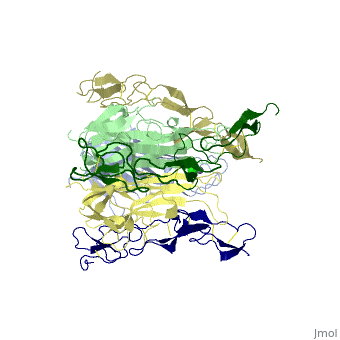TRAIL: Difference between revisions
Jump to navigation
Jump to search
Michal Harel (talk | contribs) No edit summary |
No edit summary |
||
| Line 1: | Line 1: | ||
<StructureSection load='1d0g' size='340' side='right' caption='Human TRAIL trimer residues 114-281 (grey, light green, yellow) complex with death receptor-5 extracellular domain (dark blue, dark green, olive), Zn+2 (grey) and Cl-1 (green) ions, [[1d0g]]' scene=''> | <StructureSection load='1d0g' size='340' side='right' caption='Human TRAIL trimer residues 114-281 (grey, light green, yellow) complex with death receptor-5 extracellular domain (dark blue, dark green, olive), Zn+2 (grey) and Cl-1 (green) ions, [[1d0g]]' scene=''> | ||
== Function == | == Function == | ||
'''TRAIL (TNF-related apoptosis-inducing ligand)''' functions as a ligand in the process of apoptosis<ref>PMID:15987601</ref>. TRAIL binds to death receptors DR4, DR5, DcR1 and DcR2. For details see [[Molecular Playground/TRAIL]]. | '''TRAIL (TNF-related apoptosis-inducing ligand)''' functions as a ligand in the process of apoptosis<ref>PMID:15987601</ref>. TRAIL binds to death receptors DR4, DR5, DcR1 and DcR2. For details see [[Molecular Playground/TRAIL]]. <scene name='48/480878/Cv/1'>TRAIL trimer residues complex with death receptor-5 extracellular domain</scene> ([[1d0g]]). | ||
== Disease == | == Disease == | ||
Revision as of 12:05, 27 June 2017
FunctionTRAIL (TNF-related apoptosis-inducing ligand) functions as a ligand in the process of apoptosis[1]. TRAIL binds to death receptors DR4, DR5, DcR1 and DcR2. For details see Molecular Playground/TRAIL. (1d0g). DiseaseTRAIL concentrations are reduced in rheumatoid arithritis[2]. |
| ||||||||||
3D Structures of TRAIL3D Structures of TRAIL
1d0g, 1d4v, 1du3 - hTRAIL residues 114-281 + DR5 extracellular domain - human
1dg6 – hTRAIL jelly-roll domain
1d2q - hTRAIL extracellular domain
ReferencesReferences
- ↑ Daniels RA, Turley H, Kimberley FC, Liu XS, Mongkolsapaya J, Ch'En P, Xu XN, Jin BQ, Pezzella F, Screaton GR. Expression of TRAIL and TRAIL receptors in normal and malignant tissues. Cell Res. 2005 Jun;15(6):430-8. PMID:15987601 doi:http://dx.doi.org/10.1038/sj.cr.7290311
- ↑ Dessein PH, Lopez-Mejias R, Ubilla B, Genre F, Corrales A, Hernandez JL, Ferraz-Amaro I, Tsang L, Pina T, Llorca J, Blanco R, Gonzalez-Juanatey C, Gonzalez-Gay MA. TNF-related apoptosis-inducing ligand and cardiovascular disease in rheumatoid arthritis. Clin Exp Rheumatol. 2015 Jul-Aug;33(4):491-7. Epub 2015 May 11. PMID:25962765
